
Tweed is a fabric that has always been deeply linked to the land. From its rural origins, woven with the fleeces of local sheep in colours dyed with foraged roots, berries and bark, to its use on the hills and rivers of sporting estates.
Scotland’s landscape remains my primary inspiration when designing tweed. I hope to remain true to the original spirit of that early rugged cloth, while adapting it to be used and enjoyed by a contemporary audience.
This brings with it both challenges and opportunities. Since those early natural colours, the way wool is dyed has changed dramatically, as has consumer taste. Bright punchy colours are now dominant, and it can be difficult to source shades that have the nuance and hue of those original dyes. This often results in modern tweeds moving further and further away from their natural setting in the landscape.
This shift is particularly noticeable in estate tweeds. Used for generations by those working and living on the land, they have maintained the most direct connection to the landscape. Their colours and woven textures evoke the environment they are used within, whether that is heather clad hills or river valleys fringed with trees. They are rooted in that place and frequently offer the wearer camouflage as well as protection against the elements.
Sadly, over time many estates find their original tweed has lost some of this grounding. Multiple production runs across the decades and dwindling choice of yarns in suitable colours shift historic tweeds away from their original design.
Fittingly, I have found the best way to rectify this is to return to the landscape. When I am commissioned to re-create a historic estate tweed, I will always ask about the surrounding countryside and how the tweed will be used. Seeing a tweed alongside the environment it was intended to sit within identifies contemporary changes that jar. Sometimes that is a combination of colours or a subtle change in design, which can all add up to a tweed that no longer fits.

Then the design process can begin; using the selected landscape as inspiration, together with the original tweed, I can begin to recapture this place in woven form.
As much of a tweed’s grounded quality comes down to colour, I often end up searching high and low for yarns, even at times requiring them to be bespoke dyed or twisted. These are then paired with woven structures and patterns that evoke textures found in the landscape, creating a tweed with real depth and vitality.
This also translates to creating a brand new bespoke tweed, as often my clients wish to use their tweed for sporting activities or have an area or place that is special to them. Combining colours that have a natural quality with older, more unusual tweed patterns ensures that I can create interesting tweeds in an authentic way, as well as offering something new and personal to each client.
Crafting a tweed that captures a landscape frequently has its challenges. However I believe that holding true to tweed’s roots in the land will ensure that it preserves the legacy of the past, while continuing to be relevant in the years to come.


